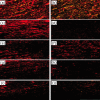Effects of dipotassium glycyrrhizinate on wound healing
- PMID: 34644769
- PMCID: PMC8516426
- DOI: 10.1590/ACB360801
Effects of dipotassium glycyrrhizinate on wound healing
Abstract
Purpose: Dipotassium glycyrrhizinate (DPG) has anti-inflammatory properties, besides promoting the regeneration of skeletal muscle. However, it has not been reported on skin wound healing/regeneration. This research aimed to characterize the effects of DPG in the treatment of excisional wounds by second intention.
Methods: Male adults (n=10) and elderly (n=10) Wistar rats were used. Two circular wounds were excised on the dorsal skin. The excised normal skins were considered adult (GAN) and elderly (GIN) naïve. For seven days, 2% DPG was applied on the proximal excision: treated adult (GADPG) and elderly (GIDPG), whereas distal excisions were untreated adult (GANT) and elderly (GINT). Wound healing areas were daily measured and removed for morphological analyses after the 14th and the 21st postoperative day. Slides were stained with hematoxylin-eosin, Masson's trichrome, and picrosirius red.
Results: Histological analysis revealed intact (GAN/GIN) and regenerated(GANT/GINT/GADPG/GIDPG) skins. No differences of wounds' size were found among treated groups. Epidermis was thicker after 14 days and thinner after 21 days of DPG administration. Higher collagen I density was found in GIDPG (14th day) and GADPG (21st day).
Conclusions: DPG induced woundhealing/skin regeneration, with collagen I, being more effective in the first 14 days after injury.
Conflict of interest statement
Conflict of interest: Nothing to declare
Figures






References
-
- Oriá RB, Ferreira FVA, Santana EN, Fernandes MR, Brito GAC. Study of age-related changes in human skin using histomorphometric and autofluorescence approaches. An Bras Dermatol. 2003;78(4):425–434. doi: 10.1590/S0365-05962003000400004. - DOI
MeSH terms
Substances
LinkOut - more resources
Full Text Sources

